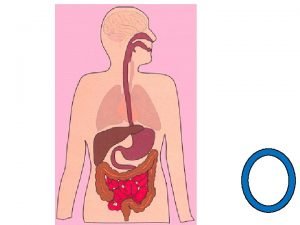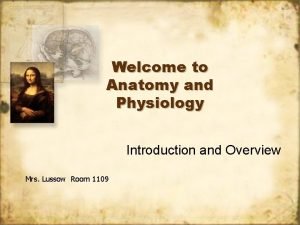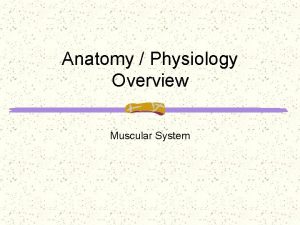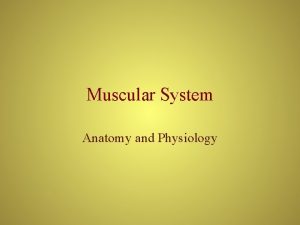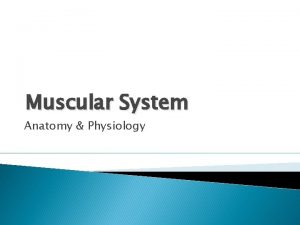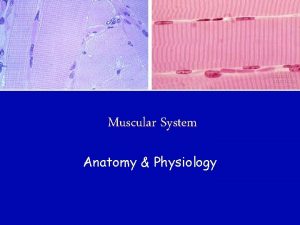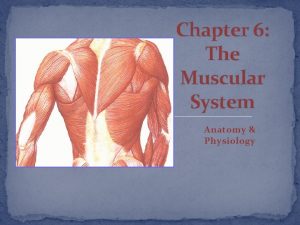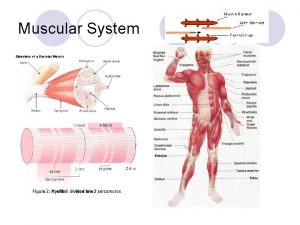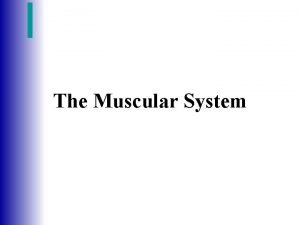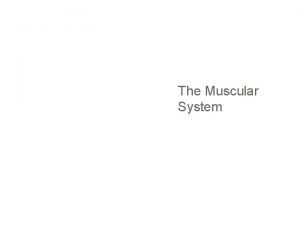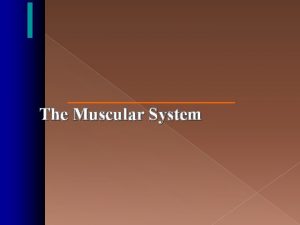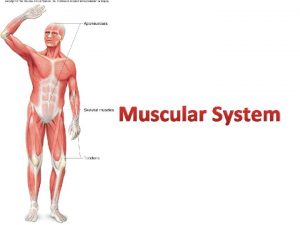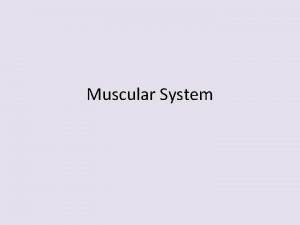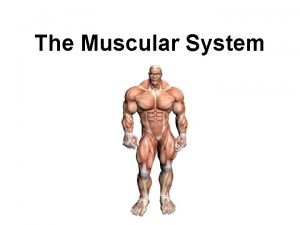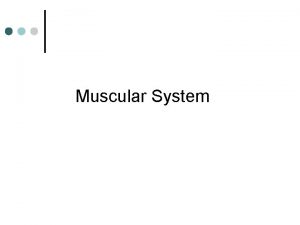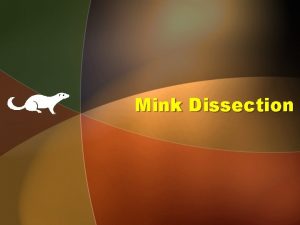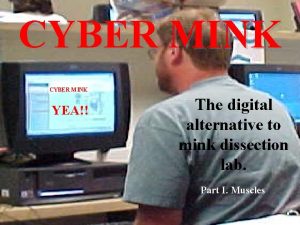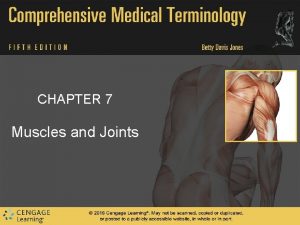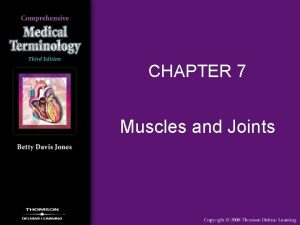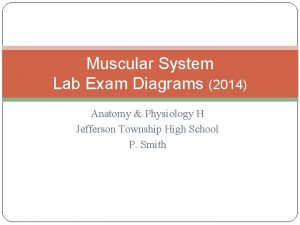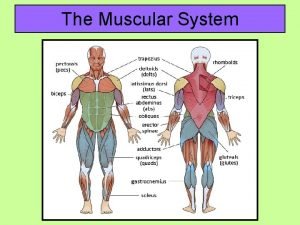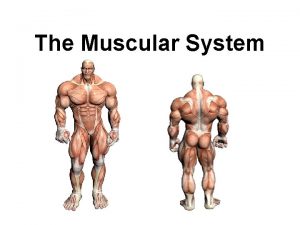Muscular System Exam Overview Anatomy Physiology Muscles Mink




















































- Slides: 52

Muscular System Exam

Overview Anatomy Physiology Muscles Mink Dissection 10 10 10 20 20 20 30 30 30 40 40 40 50 50 50

Question 1 - 10 • What are three types of muscles?

Answer 1 – 10 • Cardiac, skeletal, and smooth

Question 1 - 20 • Name the types of muscles that are uninucleated.

Answer 1 – 20 • Smooth and cardiac = uninucleated (means 1 nucleus/cell)

Question 1 - 30 • Name the type of muscle shown below. What shape are the cells?

Answer 1 – 30 • Smooth; fusiform shape (like a seal or a football)

Question 1 - 40 • What type of muscle is shown below?

Answer 1 – 40 • Cardiac and skeletal

Question 1 - 50 • What are the functions of muscles?

Answer 1 – 50 • Generate heat, posture, movement, stabilize joints

Question 2 - 10 • Draw a picture and label the following: endomysium, epimysium, perimysium, fascicle, muscle fiber, myofibril, myofilament

Answer 2 – 10

Question 2 - 20 • What is the difference between a myofibril and a myofilament?

Answer 2 – 20 • Myofibril is an organelle. Myofilaments come in thick/thin varieties and are found within a myofibril

Question 2 - 30 • Draw and label a sarcomere, including the Z disc, thick filaments, thin filaments, A band I band

Answer 2 – 30

Question 2 - 40 • If my arm was representative of a myofibril, the sleeve of my shirt would represent the ________

Answer 2 – 40 • Sarcoplasmic reticulum

Question 2 - 50 • Create an anology. Pretend we are in the classroom and there is a mechanical pencil on the ground with some pieces of lead inside representing a myofilament. What would be the endomysium, perimysium, fascicle, epimysium, myofibril? – Challenge: work sarcoplasmic reticulum into the mix!

Answer 2 – 50 • Pencil lead= myofilament • Pencil=myofibril – Gripper on the pencil = sarcoplasmic reticulum • Classroom = muscle fiber – Walls of classroom = endomysium • Science department classrooms = fascicle • Doors and walls separating the science wing from the rest of the school = perimysium • Entire school containing a collection of different departments (fascicles) = epimysium

Question 3 - 10 • Draw a picture labeling the following: neuromuscular junction, synaptic cleft, neurotransmitter, acetylcholine,

Answer 3 – 10 Acetylcholine (a neurotransmitter) is within the synaptic vesicles

Question 3 - 20 • After the acetylcholine is released in the synapse and touches the sarcolemma, what happens? You should be talking about some ions in your answer…. .

Answer 3 – 20 • The Ach causes the gated proteins to open and let sodium (Na+) inside the cell and K+ (potassium) inside the cell

Question 3 - 30 • What is it called when one sodium/potassium channel opening causes others along the length of the cell to open? This is as a result of an “upset” in electrical charge of the sarcolemma

Answer 3 – 30 • Action potential! – Remember: it is like a match. The flame travels down the length of the stick, just like the signal travels down the length of the muscle fiber

Question 3 - 40 • When enough sodium is let inside the cell, the sarcoplasmic reticulum releases __________. This will cause the _______ myofilament to bind to the _______ myofilament by _______. . .

Answer 3 – 40 • When enough sodium is let inside the cell, the sarcoplasmic reticulum releases _____calcium (Ca 2+)_____. This will cause the ____thick___ myofilament to bind to the ____thin___ myofilament by ____stimulating the regulatory proteins on the thin (actin) to allow the thick (myosin) to bind______. . .

Question 3 - 50 • One way doctors can treat a disease is to prescribe an antagonist. This acts just like a neurotransmitter, for example, and blocks the receptor sites so that way when the real molecule comes along, it cannot bind and thus prevents the neurotransmitter from sending a signal. The antagonist is like an impersonator of a neurotransmitter: it looks like the neurotransmitter, but it doesn’t act like it. Say Medicine X is an antagnoist for acetylcholine and it was released into a synapse of a neuromuscular junction. What would be the effect?

Answer 3 – 50 • The muscle would not be able to contract. The acetylcholine would be released, but all of the binding sites (the oreos from our simulation) would be occupied and remain closed. The muscle would be prevented from contracting because it never receives the acetylcholine signal

Question 4 - 10 • What is an agonist?

Answer 4 – 10 • An opposite; biceps and triceps oppose each other since one straightens the elbow and the other bends it

Question 4 - 20 • Point to your sternocleidomastoid. What does it do?

Answer 4 – 20 • It flexes your neck (chin down) – You need to know the word FLEX!!

Question 4 - 30 • Where is the deltoid? What does it do? What is its agonist?

Answer 4 – 30 • Deltoid=shoulder • Arm abduction • Agonist=pectoralis major

Question 4 - 40 • Explain the relationship between the gluteus maximus, hamstrings, and quadriceps?

Answer 4 – 40 • Gluteus maximus = hip extensor – Agonist=quadricep (hip flexor) • Hamstring = knee flexor – Agnoist: quadricep (knee extensor) – Google the difference between hip extension/flexion and knee extension/flexion if you need to see an example. Use your body as a tool! Feel what actions make your muscles contract!

Question 4 - 50 • Name the 4 muscles of the quad group and the 3 muscles of the hamstring group

Answer 4 – 50 • Quad – Vastus medialis – Vastus intermedius – Vastus lateralis – Rectus femoris • Hamstring – Semitendinosus – Semimembranosus – Biceps femoris Don’t mix up rectus femoris with biceps femoris! I know they sound similar!

Question 5 - 10 • What is #1 and #2 below?

Answer 5 – 10 • 1=sternocleidomastoid • 2=anterior portion of the trapezius

Question 5 - 20 • What is outlined below and what does it do?

Answer 5 – 20 • Rectus abdominis • Flexes the vertebrae (bend over)

Question 5 - 30 • What is #2, 3, and 4?

Answer 5 – 30 • 2= vastus lateralis (qauadricep) • 3= biceps femoris (hamstring) • 4= gluteus maximus

Question 5 - 40 • Name 2, 3, 4, 6, 7

Answer 5 – 40 • • • 2 - tibialis anterior 3 - rectus femoris (quadricep) 4 - semimembranosis (hamstring) 6 - semitendinosis (hamstring) 7 - gastrocnemius

Question 5 - 50 • For each muscle, name the action, agnosit, and action of the agonist – Sternocleidomastoid – Pectoralis major – Biceps brachii – Hamstring – Gluteus maximus – Tibialis anterior

Answer 5 – 50 – Sternocleidomastoid = flex neck • Trapezius = extend neck – Pectoralis major = arm adduction • Deltoid = arm abduction – Biceps brachii = forearm flexion • Triceps brachii = forearm extension – Hamstring = knee flexion • Quadriceps = knee extension – Gluteus maximus = hip extension • Quadriceps = hip flexion – Tibialis anterior = dorsiflexion • Gastrocnemius and soleus = plantarflexion
 Mink for dissection
Mink for dissection Anatomy and physiology exam 1
Anatomy and physiology exam 1 Anatomy and physiology unit 7 cardiovascular system
Anatomy and physiology unit 7 cardiovascular system Respiratory system in humans
Respiratory system in humans Anterior surface of scapula
Anterior surface of scapula Plyometrics disadvantages
Plyometrics disadvantages Hepatic lobules of liver
Hepatic lobules of liver Pulmonary tract
Pulmonary tract Tattoo anatomy and physiology
Tattoo anatomy and physiology International anatomy olympiad
International anatomy olympiad Specialized stems examples
Specialized stems examples Anatomy and physiology of bone
Anatomy and physiology of bone Ulcer anatomy
Ulcer anatomy Segmental anatomy of the liver
Segmental anatomy of the liver Hypogastric region
Hypogastric region Hypogastric region
Hypogastric region Anatomy and physiology of blood
Anatomy and physiology of blood Chapter 14 anatomy and physiology
Chapter 14 anatomy and physiology Endomysium
Endomysium Http://anatomy and physiology
Http://anatomy and physiology Waistline
Waistline Anatomy and physiology of appendix
Anatomy and physiology of appendix Aohs foundations of anatomy and physiology 1
Aohs foundations of anatomy and physiology 1 Aohs foundations of anatomy and physiology 1
Aohs foundations of anatomy and physiology 1 Anatomy and physiology of swine
Anatomy and physiology of swine Anatomy and physiology chapter 8 special senses
Anatomy and physiology chapter 8 special senses Chapter 13 anatomy and physiology of pregnancy
Chapter 13 anatomy and physiology of pregnancy Unit 26 animal anatomy physiology and nutrition
Unit 26 animal anatomy physiology and nutrition Science olympiad forensics cheat sheet
Science olympiad forensics cheat sheet Anatomy and physiology chapter 2
Anatomy and physiology chapter 2 Contraction
Contraction Anatomy and physiology of pancreas in diabetes
Anatomy and physiology of pancreas in diabetes Chapter 7:9 lymphatic system
Chapter 7:9 lymphatic system Anatomy and physiology coloring workbook chapter 14
Anatomy and physiology coloring workbook chapter 14 Chapter 10 blood anatomy and physiology
Chapter 10 blood anatomy and physiology Aohs foundations of anatomy and physiology 1
Aohs foundations of anatomy and physiology 1 Aohs foundations of anatomy and physiology 1
Aohs foundations of anatomy and physiology 1 What produces bile
What produces bile Anatomy and physiology chapter 15
Anatomy and physiology chapter 15 Cornell notes for anatomy and physiology
Cornell notes for anatomy and physiology Anatomy and physiology edition 9
Anatomy and physiology edition 9 Necessary life functions anatomy and physiology
Necessary life functions anatomy and physiology Holes anatomy and physiology chapter 1
Holes anatomy and physiology chapter 1 Holes essential of human anatomy and physiology
Holes essential of human anatomy and physiology Anatomy and physiology chapter 15
Anatomy and physiology chapter 15 Anatomy and physiology
Anatomy and physiology Chapter 1 introduction to anatomy and physiology
Chapter 1 introduction to anatomy and physiology Aohs foundations of anatomy and physiology 1
Aohs foundations of anatomy and physiology 1 Aohs foundations of anatomy and physiology 1
Aohs foundations of anatomy and physiology 1 Chapter 1 an introduction to anatomy and physiology
Chapter 1 an introduction to anatomy and physiology Welcome to anatomy and physiology
Welcome to anatomy and physiology Physiology of the foot and ankle
Physiology of the foot and ankle Anatomy and physiology of psoriasis
Anatomy and physiology of psoriasis






